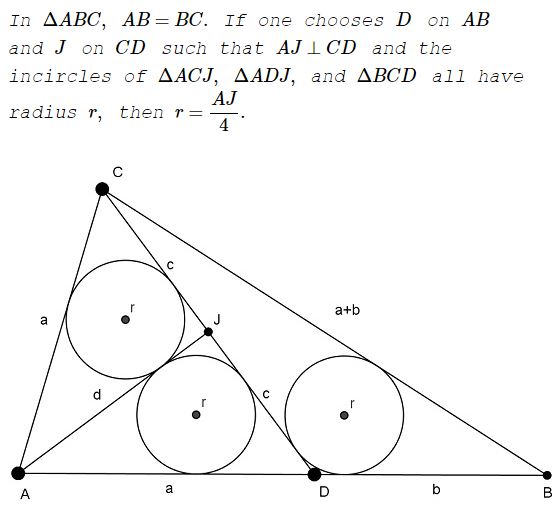A Simple Solution to a Difficult Sangaku Problem
Nikolaos Dergiades
Thessaloniki Greece
May 15, 2017

Solution
Since the incircles of triangles $AJC,\,$ $AJD\,$ are symmetric relative to $AJ,\,$ the same holds for $AC,\,$ $AD\,$ and hence $AC=AD=a,\,$ $CJ=JD=c.\,$
If $AJ=d,\,$ $DB=b,\,$ then $BC=a+b.$
From $\Delta CDB,\,$ $\displaystyle r=\frac{2[CDB]}{CD+DB+BA}=\frac{[CDB]}{\displaystyle \frac{a}{2}+b+c}.$
From $\Delta CAJ,\,$ $\displaystyle r=\frac{2[CAJ]}{a+c+d}=\frac{[CAD]}{a+c+d}.$
Hence, $\displaystyle \frac{b}{a}=\frac{[CDB]}{[CAD]}=\frac{\displaystyle \frac{a}{2}+b+c}{\displaystyle a+c+d}=\frac{\displaystyle \frac{a}{2}+c}{\displaystyle c+d},$
from which
(1)
$\displaystyle b=\frac{a(a+2c)}{2(c+d)}.$
Stewart's theorem gives,
$CA^2\cdot DB+CB^2\cdot AD=CD^2\cdot AB+AD\cdot DB\cdot AB,$
i.e., $a^2b+(a+b)^2a=4c^2(a+b)+ab(a+b),\,$ from which
(2)
$\displaystyle b=\frac{a(4c^2-a^2)}{2(a^2-2c^2)}.$
From (1) and (2) we conclude that $a^2-2c^2\ne 0\,$ and $\displaystyle c+d=\frac{a^2-2c^2}{2c-a}.$
In $\Delta CAJ,\,$ the Pythagorean theorem gives $a^2-c^2=d^2,\,$ such that $a^2-2c^2=(d+c)(d-c)\,$ and
$\displaystyle a^2-2c^2=\frac{a^2-2c^2}{2c-a}\cdot\frac{a^2+2ac-6c^2}{2c-a},$
implying $3a=5c,\,$ or $a=5x,\,$ $c=3x,\,$ $d=4x\,$ and, since $a=(c-r)+(d-r),\,$ we get $\displaystyle r=x=\frac{d}{4}=\frac{AJ}{4}.$
Sangaku
- Sangaku: Reflections on the Phenomenon
- Critique of My View and a Response
- 1 + 27 = 12 + 16 Sangaku
- 3-4-5 Triangle by a Kid
- 7 = 2 + 5 Sangaku
- A 49th Degree Challenge
- A Geometric Mean Sangaku
- A Hard but Important Sangaku
- A Restored Sangaku Problem
- A better solution to a difficult sangaku problem
- A Simple Solution to a Difficult Sangaku Problem
- A Trigonometric Solution to a Difficult Sangaku Problem
- A Sangaku: Two Unrelated Circles
- A Sangaku by a Teen
- A Sangaku Follow-Up on an Archimedes' Lemma
- A Sangaku with an Egyptian Attachment
- A Sangaku with Many Circles and Some
- A Sushi Morsel
- An Old Japanese Theorem
- Archimedes Twins in the Edo Period
- Arithmetic Mean Sangaku
- Bottema Shatters Japan's Seclusion
- Chain of Circles on a Chord
- Circles and Semicircles in Rectangle
- Circles in a Circular Segment
- Circles Lined on the Legs of a Right Triangle
- Equal Incircles Theorem
- Equilateral Triangle, Straight Line and Tangent Circles
- Equilateral Triangles and Incircles in a Square
- Five Incircles in a Square
- Four Hinged Squares
- Four Incircles in Equilateral Triangle
- Gion Shrine Problem
- Harmonic Mean Sangaku
- Heron's Problem
- In the Wasan Spirit
- Incenters in Cyclic Quadrilateral
- Japanese Art and Mathematics
- Malfatti's Problem
- Maximal Properties of the Pythagorean Relation
- Neuberg Sangaku
- Out of Pentagon Sangaku
- Peacock Tail Sangaku
- Pentagon Proportions Sangaku
- Proportions in Square
- Pythagoras and Vecten Break Japan's Isolation
- Radius of a Circle by Paper Folding
- Review of Sacred Mathematics
- Sangaku à la V. Thebault
- Sangaku and The Egyptian Triangle
- Sangaku in a Square
- Sangaku Iterations, Is it Wasan?
- Sangaku with 8 Circles
- Sangaku with Angle between a Tangent and a Chord
- Sangaku with Quadratic Optimization
- Sangaku with Three Mixtilinear Circles
- Sangaku with Versines
- Sangakus with a Mixtilinear Circle
- Sequences of Touching Circles
- Square and Circle in a Gothic Cupola
- Steiner's Sangaku
- Tangent Circles and an Isosceles Triangle
- The Squinting Eyes Theorem
- Three Incircles In a Right Triangle
- Three Squares and Two Ellipses
- Three Tangent Circles Sangaku
- Triangles, Squares and Areas from Temple Geometry
- Two Arbelos, Two Chains
- Two Circles in an Angle
- Two Sangaku with Equal Incircles
- Another Sangaku in Square
- Sangaku via Peru
- FJG Capitan's Sangaku
|Up| |Contact| |Front page| |Contents| |Geometry|
Copyright © 1996-2018 Alexander Bogomolny
73447506
